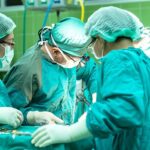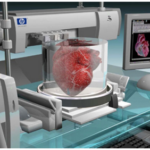

A diagnosis of one tumor is bad enough – imagine being diagnosed with 50. That’s what a patient named Maureen was facing after suffering from abdominal pain for years. Her doctors told her that she had so many fibroids in her uterus that the only option would be to remove it in a hysterectomy. She refused. To seek alternative treatment, Maureen was referred to the Shirley E. Greenberg Women’s Health Centre at the Ottawa Hospital, where she met with the Minimally Invasive Gynecology team.
Dr. Sony Singh is a surgeon and the Elaine Jolly Research Chair in Surgical Gynecology. Maureen’s diagnosis was a challenging one, but Dr. Singh was up for it – he said he could remove all 50 fibroids while leaving the patient’s womb intact.
“Maureen had close to 50 fibroids and we wanted to make sure her uterus was able to carry a baby in the future and function normally,” said Dr. Singh. “But we needed help to plan the complicated surgery to remove them.”
In 2017, the Ottawa Hospital opened a 3D Printing Lab and became the first in Canada to offer an integrated medical 3D printing program for research and education. The Director of the 3D Printing Program, Dr. Adnan Sheikh, said that the orthopedics department is one of the main users of the lab, 3D printing models for orthopedic oncology.
“3D printing is revolutionizing the way we look at anatomy,” said Orthopedic Surgeon and Oncologist Dr. Joel Werier. “It adds another perspective to how we view tumours, how we plan our surgery techniques, and our ability to offer precision surgery.”
Research Associate Dr. Teresa Flaxman found it difficult to see Maureen’s tumors on her MRI scans, so she turned to the 3D Printing Lab for help. Maureen’s case was a new challenge for the lab. According to Dr. Flaxman, it’s relatively easy to 3D print bones from MRI or CT scans, but soft tissue, such as uterine tissue, is more difficult. This would be the first 3D printed uterus that the hospital would create.
“This was a very challenging case,” said Dr. Sheikh. “The multiple fibroids within the uterine cavity made it very difficult to print, and we had to identify each one of them, in order to replicate the exact anatomy on a 3D-printed model. We used a softer, flexible material to create the model that was more consistent with uterine tissue.”

Dr. Flaxman and other researchers from the Women’s Health Centre worked with Waleed Althobaity and Olivier Miguel at the 3D Printing Lab to create a 3D model of Maureen’s uterus, which was then printed. The patient’s uterus, because of the fibroids, was 20 times bigger than a normal one, but the team scaled it down eight times to 3D print it. The model took 14 hours to 3D print. Once it was printed, the model helped Dr. Singh and the rest of the surgical team to see exactly where the fibroids were located.
“This model helped to provide a good visual aspect. To have a model in my hands during surgery was incredible,” said Dr. Singh. “At the same time, we also had 3D images that I could look at on a TV screen in the operating room. It seems very futuristic, but in the operating room I was able to turn the image of the uterus at any angle or degree that I wanted, so I could see it from different perspectives, which helped during surgery.”
The 3D printed model also helped Maureen to understand what was going on inside her, and to know what to expect from her surgery.
“Just before my surgery, Dr. Singh brought the model to me,” said Maureen. “He explained how he could use it in the surgery to see where the fibroids are, and he asked my permission to use it during the operation.”
It was an easy answer, and she gave her permission. The fibroids were successfully removed in a surgery that was, according to Ottawa Hospital, the first gynecological surgery to be completed with the help of a 3D printed model.
“By working together with the 3D Printing Lab at The Ottawa Hospital, we’re going to be one of the first hospitals internationally to study how we can provide this improved care by using 3D-printed models in planning surgery for women’s health,” said Dr. Flaxman.
Maureen still has her uterus, which is now fibroid-free, and according to Dr. Singh she still has a hope of carrying a baby. The 3D Printing Lab is now working on similar projects with the Minimally Invasive Gynecology team to offer alternatives to other women.
Discuss this and other 3D printing topics at 3DPrintBoard.com or share your thoughts below.
[Source/Images: Ottawa Hospital Foundation]
If you're looking to get architectural 3D animation in the USA, our service provides an exceptional way to bring your architectural concepts to life through dynamic, immersive visuals. Through our platform, you can easily request high-quality 3D animations that showcase your designs in motion, offering a detailed view of your project from multiple angles and perspectives. Whether it's for a real estate development, a commercial building, or an urban planning project, our expert team ensures that every detail is captured in a visually compelling animation.
Through our website, you can seamlessly get architectural 3D animation tailored to your project’s specific needs. With our help, you can offer potential clients or investors an engaging experience that goes beyond static images. By integrating CGI animations with real-world settings, lighting, and textures, our team creates a lifelike experience that allows your audience to interact with your project as though it were already built. This service is perfect for presenting complex designs in a clear, visually attractive way that stands out in the competitive architectural market.




